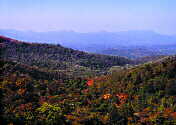|
|

By George
Testani and Ramaiah
Surprising? Not to those in the industry who know beans about their
coffee. Close to 300,000 tons of it (and rising steadily) are produced
annually. In fact, the cultivation of coffee in India dates back
to 1600 A.D. when a holy man from India (Baba Budan) brought six
coffee seeds from Yemen and planted them. Although India is primarily
associated with tea, high quality estate coffee production had been
neglected for the most part--until recently.
Riding the wave of this recent explosion from India is a company
called Plantation Direct Associates(PDA).
Owners of 400 acres for the past 30 years, this large family-owned
plantation is committed to informing the world about Indian coffee.
The plantations are at elevations of between 4,000 - 5,400 feet
located on the windward side of the Western Ghats in the Chickmagalur
District within the Bababudangiri ranges. The high altitude has
a profoundly positive effect on the quality of the coffees. However,
it also presents many difficulties for the farmers and skilled laborers.
Yields of coffee per acre are significantly less than those from
plantations at lower altitudes. Picking of the cherries on these
slopes is much more difficult as well as the transport of these
cherries to the curer. The soils are acidic in nature and lateric
in origin.
|



|
They
are also rich in nitrogen and potassium; moderate in phosphorus;
and adequate in iron, manganese, copper and molybdenum. They have
also been supplied regularly with calcium, magnesium, sulphur and
zinc.
With respect to climate, the estate has an ideal annual rainfall
of 90-100 inches (well distributed from April through November)
and a dry spell from December to March/April which helps in processing
and in natural sun drying of the Arabica coffee. The coffee is grown
in the shade of trees such as Dalbergia (Rosewood), Ficus, Silver
Oak, Jack and Albizzia.
The plantation owners are interested in not only the sustainability
of the land and coffee, but also that of the estate laborers. To
this end, they provide the workers with clothing, housing, training,
medical and other amenities as well as education for the children.
These provisions for both laborers and children are rare in that
many countries have not yet fully embraced them.
Commercial Arabica A, B and PB are available from lower-elevation
plantations as well as Monsooned Malabar and washed Robusta, whose
production faces future problems as a result of the
Vietnamese crop and London markets' pushing its price to an eight-year
low.
Farmers are amazed that high-quality, high-altitude, shade-grown
coffee does not yet command the higher prices other nations enjoy.
Those offering the best coffee will find their place in the Specialty
Market as other farmers continue to elevate the quality of their
own coffee for greater sustainability as well.
India Arabica coffees (grouped with "other milds" in the
International Coffee Market) are bestowed with wonderful aroma,
slightly acid body, smooth taste and medium-to-full body without
any harshness. |

|








|














